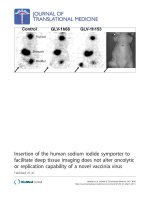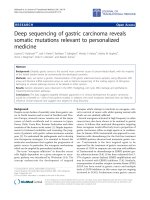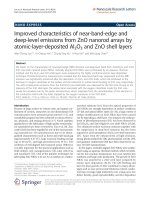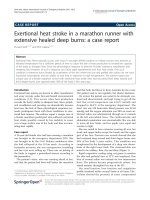IPoDWDM deep dive Jusep Unserman
Bạn đang xem bản rút gọn của tài liệu. Xem và tải ngay bản đầy đủ của tài liệu tại đây (8.06 MB, 57 trang )
IPoDWDM and
IP NGN Core design
Josef Ungerman
Cisco, CCIE #6167
© 2010 Cisco and/or its affiliates. All rights reserved.
Cisco Confidential
1
• Motivations for IP NGN
• Trends is IP/MPLS Core Design
• Making Routers Cheaper
• IPoDWDM
• Pre-FEC proactive protection
• 100GE and 40GE
• Future
© 2010 Cisco and/or its affiliates. All rights reserved.
Cisco Confidential
2
IP Traffic will increase 4x from 2009 to 2014
(34% CAGR)
IP Traffic
IP Traffic grew 45%
in 2009
Mobile Data Traffic
will double every
year
Video will be 66% of
mobile data, and
91% of global traffic
Internet Traffic
© 2010 Cisco and/or its affiliates. All rights reserved.
Source: Cisco Visual Networking Index—Forecast, 2009–2014 [Cisco VNE]
Business IP traffic
will increase 2.6x
(21% CAGR), only
video will grow 10x
Central & Eastern
Europe will be
2.3EB/month (3.6%
of the global
64EB/month)
Cisco Confidential
3
How to move bits cheaper...
...reduce OPEX, CAPEX, and keep reasonable quality?
1)
Reduce the number of networks
2)
Reduce the number of layers
3)
Reduce the number of nodes
4)
Reduce the number of links
5)
Use modern technologies
the largest portion of the traffic will rule the design
the largest portion of the traffic must be as close to fiber as
possible, eliminate overlay
the largest portion of the traffic must pass the lowest possible
number of nodes
the number of changes in the network must be minimal when
adding more capacity; use statistical multiplex - small traffic
follows big traffic
Watch TCO,
Price/Performance ratio, Watt/Gigabit ratio,
investment protection (h/w upgradeability, s/w roadmaps)
© 2010 Cisco and/or its affiliates. All rights reserved.
Cisco Confidential
4
© 2010 Cisco and/or its affiliates. All rights reserved.
Cisco Confidential
5
• IP NGN = Single Multiservice Network
Not multiple single-service networks. Key enablers are Virtualization, QoS and Security.
• IP NGN = MPLS + DWDM Optical Transport
Moving bits cheaper. 100GE evolution, Price/Gigabit and Watt/Gigabit reduction.
• IP NGN = optimal balance between Clouds and Circuits
Statistical Multiplex (IP/MPLS, MPLS-TP) and Division Multiplex (DWDM, OTN).
© 2010 Cisco and/or its affiliates. All rights reserved.
Cisco Confidential
6
Designing End to End IP/MPLS
networks
Hierarchy
Hierarchical Design
(divide & conquer approach)
PE is always connected to P
Simple upgrades
Static Transport Layer
Protection is in the IP domain
© 2010 Cisco and/or its affiliates. All rights reserved.
Router Bypass
• Hierarchical Design
with optical router bypass
• Still simple upgrades
• Cheaper bandwidth
• Quality is kept
Hollow Core idea
Flat Design
(full mesh between IP routers)
Fewer nodes, Much more Links
Complex upgrades, complex QoS
Dynamic Transport Layer
(G.MPLS, VCAT/ODU-FLEX)
Protection in the Optical domain
Cisco Confidential
7
Metro
Aggregation
BNG
(Edge)
The
The Quality
Quality of
of IP
IP NGN
NGN Design
Design
•• Hierarchy
Hierarchy (P
(P is
is connected
connected to
to PE)
PE)
•• One
One network,
network, one
one IGP
IGP (not
(not multiple)
multiple)
•• QoS
QoS and
and Security
Security everywhere
everywhere
•• Scalability
Scalability –– where
where will
will 40/100GE
40/100GE start?
start?
SSN – Single Service Node (eg. BRAS, IGW)
MSN – Multiservice Node (eg. P router)
Core
•SSN-MSN link = ok
Internet Gateways
safe operation
•MSN-MSN link = think twice!
such link needs proper QoS and capacity mgt
•SSN-SSN link = stop!
don’t break the hierarchy, don’t create another net
© 2010 Cisco and/or its affiliates. All rights reserved.
Cisco Confidential
8
Statistical Multiplexing
Creates an IP hierarchy
DWDM or dark fiber – direct link
(optical layer bypass)
Creates an IP mesh
Too large distances – OTN switch
(transport layer bypass)
© 2010 Cisco and/or its affiliates. All rights reserved.
Cisco Confidential
9
100GE
IEEE 802.3ba ratified
CRS-3 today, in 2011/12 also ASR9K & Nexus7K
OTN (Optical Transport Network)
OTN Framing
implemented today for Ethernet interfaces – ITU-T G.709
CRS, ASR9000, 7600, CPT, ONS (ODU2e, ODU3, future ODU4)
OTN Aggregation
implemented today for 10GE
ONS15454 Muxponder
ODU3 (future Any-Rate, ODU4, MPLS-TP)
OTN Switching
geographically very large countries, or very dense 10G E-Line networks (G.MPLS)
developed for next generation portfolio
© 2010 Cisco and/or its affiliates. All rights reserved.
Cisco Confidential
10
100G lambda
100G SR
100G lambdas
OTN
10G lambda
10G and 100G DWDM
Coexistence
10G and 100G lambdas co-exist on same fibre
Packet uses 100G, everything else 10G
Advantages
Only high demand clients upgraded to 100G
Protects existing 10G DWDM investment
Lowest cost per bit (100G TXPs>10 x10G TXPs)
Disadvantages
Need a guard band between 10G and 100G
frequencies
Not appealing in ULH environments
© 2010 Cisco and/or its affiliates. All rights reserved.
OTN
10G SR
OTN Multiplexing
• All lambdas upgraded to 100Gbps
• Sub-100G services provided by OTN OEO
Advantages
All lambdas on a fibre are 100G
Disadvantages
100TXP investment upfront
Need an additional OTN OEO
All 10G TXPs are obsolete
Cisco Confidential
11
No
No
No
No
No
No
© 2010 Cisco and/or its affiliates. All rights reserved.
Cisco Confidential
12
35bn
domain for OTN
30bn
25bn
domain for MPLS
20bn
15bn
10bn
5bn
Wholesale and retail Ethernet services :
E-Line, E-Tree and E-LAN
~90% of Ethernet market place <1GE in 2013
What is the most efficient way to support these
Ethernet Services? OTN circuits or Packets?
Source Infonetics 2009 and Cisco VNI
© 2010 Cisco and/or its affiliates. All rights reserved.
Circuit
Packet
Cisco Confidential
13
Routers
Presentation_ID
© 2010 Cisco and/or its affiliates. All rights reserved.
Cisco Confidential
14
NEW
Routers: 23% Cumulative Average $/Gbps Drop per year / fewer ASICs
Optics: $/G stays flat (best case) or increases from one technology to the next
Cisco Core Router Example
10G/40G/100G Networking Ports Biannual Worldwide
and Regional Market Size and Forecasts
May 2010
• Silicon has fundamentally followed Moore’s law
• Optics is fundamentally an analog problem
© 2010 Cisco and/or its affiliates. All rights reserved.
Cisco Confidential
15
1)
Compact Anatomy
2)
Linecard Architecture
3)
Special Core-facing Linecards
4)
Oversubscribed Cards
5)
Power Consumption
RSP, Route/Switch Processor (instead of RP and FC)
Ethernet-oriented Linecard (non-modular, less memory)
4x 10G NPU (instead of 1x 40G NPU)
one full-duplex NPU shared for rx and tx (instead of 2 dedicated NPU’s)
2x 40G fabric interface (instead of 1x 80G fabric interface)
8/16 queues per port (instead of thousands)
lower-scale NPU (no need for thousands of interfaces)
licenses for features that not everybody uses (IPoDWDM, SyncE, VPN,...)
2:1 ingress overbooking (eg. GPON Aggregation or Intra PoP PE links)
newer chips, fewer chips = 50+% Watt-per-Gigabit savings
© 2010 Cisco and/or its affiliates. All rights reserved.
Cisco Confidential
16
Cisco CRS
very modular router anatomy
RP (active)
MSC-40
NP
Q
buff.
Q
NP
buff.
Q
buff.
NP’
FP-40
PLIM
buff.
NP
Q
NP
IOS
Q
buff.
FP-140– 140G
buff.
Q
Q
IOS
IOS
Q
IOS
4, 8 or 16 Linecard slots + 2 RP slots
BRKIPM-2012
Switch Fabric Cards
(all 8 active)
MSC-140 –
140G
buff.
NP’ Q
Q
IOS
Q
141G
141G rx
rx
225G
tx
225G tx
© 2010 Cisco Systems, Inc. All rights reserved.
IOS
NP’
NP’ Q
buff.
midplane 140G
100GE
midplane 140G
SPA
midplane 40G
SIP-800
SPA
IOS
midplane 40G
IOS
RP (standby)
14x 10GE
QFA
QFA (Quantum
(Quantum Flow
Flow Array)
Array)
-- 140
140 Gbps,
Gbps, 125
125 Mpps
Mpps NPU
NPU
-- one
one for
for RX,
RX, one
one for
for TX
TX
processing
processing
17
Cisco ASR9000
compact router/switch anatomy
Trident
Trident NPU
NPU
-- 15
15 Gbps,
Gbps, 14
14 Mpps
Mpps (2x)
(2x)
-- shared
for
RX
shared for RX && TX
TX processing
processing
-- more
independent
NPU’s
more independent NPU’s per
per card
card
IOS
Transport LC – 40G
buff. NP
buff. NP
buff. NP
RSP (active)
IOS
RSP
RSP (Route/Switch
(Route/Switch
Processor)
Processor)
• • CPU
CPU ++ Switch
Switch Fabric
Fabric
• • active/active
active/active SF
SF
Transport LC – 8x TGE OS
NP buff.
90G
90G
IOS
IOS
buff. NP
buff. NP
buff. NP
buff. NP
buff. NP
NP buff.
NP buff.
Transport LC – 80G
buff. NP
buff. NP
NP buff.
RSP (fab. active)
IOS
IOS
buff. NP
buff. NP
Transport LC – 16x TGE OS
NP buff.
NP buff.
IOS
IOS
NP buff.
NP buff.
NP buff.
NP buff.
NP buff.
NP buff.
4 or 8 Linecard slots
BRKIPM-2012
© 2010 Cisco Systems, Inc. All rights reserved.
18
Edge-facing Card
CRS-1
EMSE MSC40
$50K
ES+ 4TG
$39K
CRS-3
EMSE MSC140
$29K
7600
ASR9000
A9K-8T-B
$16K
Core-facing Card
Over-subscribed Card
FP40 + 4xTGE
$19K
ES+T 4TG
$16K
FP140 + 14xTGE
$18K
A9K-8T-L
$9.25K
FP40 + 8xTGE
$16K
FP140 + 20xTGE
$15K
-
A9K-8T/4-L
-
$5.75K
Watt per TGE (max.)
CRS-1
MSC40 + 4xTGE
125 W
7600
76-ES+4T
100 W
MSC/FP + 14xTGE
43 W
CRS-1
ASR9000
CRS-3
© 2010 Cisco and/or its affiliates. All rights reserved.
FP40 + 4xTGE
105 W
A9K-8T
78 W
Cisco Confidential
19
IPoDWDM
Presentation_ID
© 2010 Cisco and/or its affiliates. All rights reserved.
Cisco Confidential
20
OTN OEO SDH/SONET Solution
Router
Transponders
or DWDM I/F
Short Reach
Optics I/F
Cross
Connect
(XC)
Invest in High Capacity SDH/SONET/OTN
10 transponders needed
4-14 Short Reach optics
Every Lambda OEO
Addt’l transponder & SR for each λ
Expensive switch w/active electronics
Continue to Invest in XCs & Transponders
© 2010 Cisco and/or its affiliates. All rights reserved.
IPoDWDM Solution
Router
Tunable
DWDM I/F
ROADMs
Invest in IPoDWDM
0 transponders needed
2 Tunable DWDM interfaces in router
All pass-through traffic stays optical
ROADM full provisioned, no truck rolls
Expensive switch eliminated
Eliminate Unnecessary OEO XC & Transponders
Cisco Confidential
21
IP Layer Management
Metro
Network
Optical Layer Management
Transponders
converting short
reach to λ
Core
Router
Metro
Network
Electrical switching
– OEO conversions
P2P DWDM
Manual patching of
10G connections
© 2010 Cisco and/or its affiliates. All rights reserved.
Electrical XC
Cisco Confidential
22
Common Network Management and Control
Metro
Network
Integrated
transponders
Core
Router
Metro
Network
Photonic
switching –
no OEO
conversions
Mesh
ROADM
© 2010 Cisco and/or its affiliates. All rights reserved.
ROADM
Cisco Confidential
23
• Integration of core routers with optical transport platform
2 layer in one
reduced OPEX
Eliminates need O-E-O modules (transponders) in transport platform
Integration at control plane level (pre-FEC FRR) to improve network resiliency
• Increased rack space and power efficiency
• Possible integration with 3rd party transport equipment
• Improves OSNR, CD and PMD robustness through use of advanced
modulations for high speed channels
ODB, DPSK+ for 40 Gbps
CP-DQPSK planned for 100 Gbps
• Available for CRS, ASR 9000, 7600, and 12000
© 2010 Cisco and/or its affiliates. All rights reserved.
Cisco Confidential
24
Before
Router
ROADM
DWDM I/F
Router Transponder ROADM
Transponder
Integrated into Router
© 2010 Cisco and/or its affiliates. All rights reserved.
Cisco Confidential
25









